

© Shipping Wonders of the World 2012-

Ships in Postage Stamps
A complete pictorial history of the development of ships from the earliest times to the present day can be traced from the designs of postage stamps issued by many countries
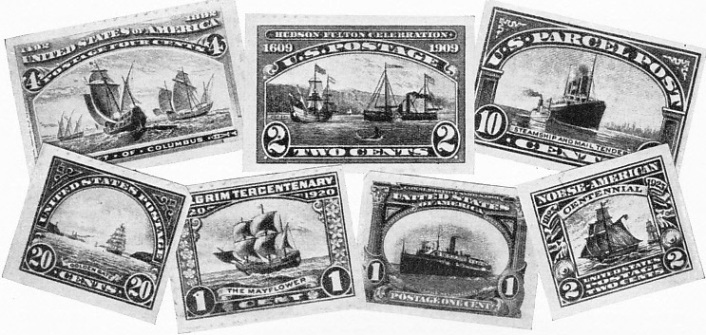
UNITED STATES POSTAGE STAMPS illustrate more types of ships than the stamps of any other nation. The voyages of Columbus, of Hudson and of the Vikings, the opening of the Panama Canal and many other famous incidents of sea history can be illustrated by a collection of these stamps.
NEARLY all the maritime nations of the world have issued at one time or another postage stamps that picture some form of ship or boat. Some are crude and inaccurately drawn, others are nautically and artistically correct. The United States heads the list of nations with the greatest number of stamp designs, incorporating pictures of ships from a Norse galley to a modern mail liner. Portugal has probably issued the next greatest number of ship stamps.
Although most of the British Dominions and Colonies have issued stamps that illustrate various types of ship, Great Britain, the supreme maritime nation, has never issued a design showing a ship.
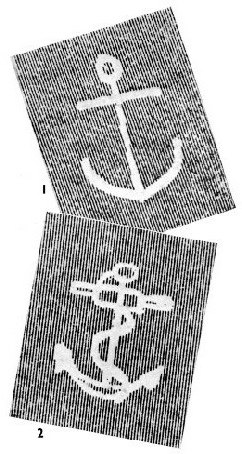 The only signs that British stamps show of any connexion with the history of the sea or its tradition are the dolphins under the head of King George V, and the anchor watermarks in issues between 1853 and 1883. Two anchor watermarks were of the crude outline shown in the illustration (1) on this page. The other two designs showed the conventional “foul anchor” (2).
The only signs that British stamps show of any connexion with the history of the sea or its tradition are the dolphins under the head of King George V, and the anchor watermarks in issues between 1853 and 1883. Two anchor watermarks were of the crude outline shown in the illustration (1) on this page. The other two designs showed the conventional “foul anchor” (2).
THE ANCHOR WATERMARK (1) was used in high-
This anchor is so “fouled” by its cable twisted round shank and flukes that if it occurred in real life the first pull would force the anchor from its hold and leave the ship to drag her anchor after her into disaster. At the other extreme from this meagre hint of British sea power and tradition, the stamps of the United States of America show that the U.S. Post Office authorities have taken every opportunity to illustrate the maritime history of their nation.
In a collection of U.S. stamps will be found recorded the exploring voyages of the Norse Vikings, the discoveries of Columbus, Hudson and other navigators, the launch of America’s first steamship, the building of the Panama Canal and, finally, the types of vessel in use as ocean liners, lake and river steamers, or as mail boats and tenders.
The oldest form of sea-
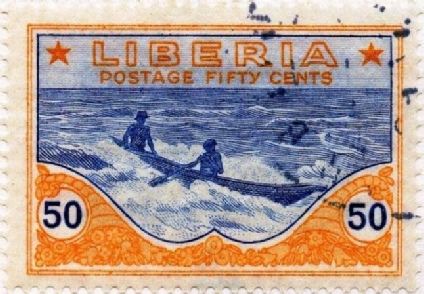
(3) THE EARLIEST SEA-
Interesting representations and drawings of the ships of the early dynastic days are common among the monuments of Egypt. The Egyptian postage stamp illustrated (4) shows an early ship under oar and sail power. It is copied from a mural picture in the temple of Deir-
The details of the original may be seen and the picture gives interesting information about the early types of hull, rigging and sails. From the number of rowers, and also by comparison with the many other drawings and models excavated from various tombs, it is estimated this vessel would have been about 70 feet in length, with a breadth of about 18 feet and a depth of 4 or 5 feet.
The line that rises from near the bow and passes along to the stern above the heads of the rowers represents a heavy rope supported on crutches or “queen posts”. It was designed to relieve longitudinal strain and to prevent the ends of the vessel from dropping or “hogging”. When this rope truss was in position, it was tightened by passing a short spar through a loop in the rope and twisting it round. The big single square-
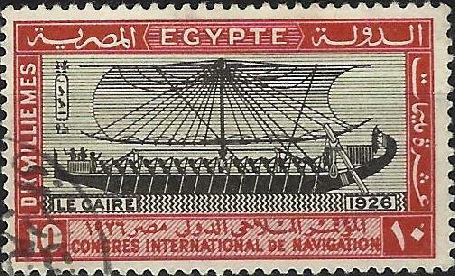
(4) THE EGYPTIAN STAMP issued during the International Navigation Congress in December 1926 shows an ancient sail-
In the illustration of the ancient Egyptian ship it would seem that the vessel is sailing with the wind at right angles to the ship’s course. It is certain, however, that such a vessel of shallow draught, and with a single mast stepped amidships, could never have made a foot of headway. The explanation of the sail’s position in the picture is simply the convention of old Egyptian art; by which perspective was evaded. The artist drew every detail in one dimension and plane, regardless of whether he could so see it from the angle of his drawing or not.
Arab influences
A square sail of this type could be used only with the wind well astern and not at all with the wind broadside on or a little ahead. It came to be displaced, therefore, in Egypt and the Mediterranean by the fore-
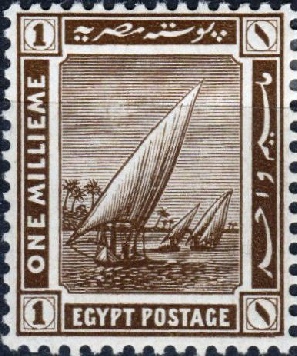
(5) THE LATEEN SAILS still in use to-
It is a matter of some dispute or doubt whether this lateen sail was developed in Egypt from the old square-
The other theory is that the lateen sail was introduced by the Arabs, to whom it had come by way of the East Indies, India and Persia from the Pacific Islands. In postage stamp designs may be seen types that seem to support either theory to some extent.
In the Sudanese stamp (6), although the main subject is an armoured river steamer, there is also a native boat with a sail that closely resembles the widespread square-
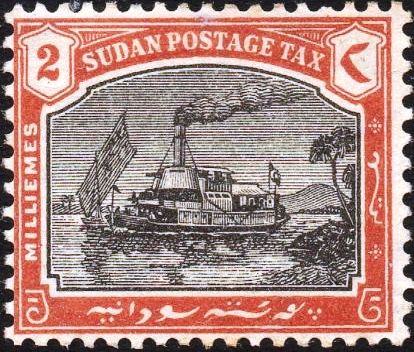
(6) ARMOURED STEAMER on the River Nile, illustrated in a Postage Due stamp issued by the Anglo-
The rigs of Egypt, gradually spreading down the coast of the Red Sea, would meet and mingle with the Arab types of rigging. We see a further stage in the development of the triangular lateen sail in a stamp of Zanzibar (7). If the sail of the outrigger canoe on this stamp is examined closely it will be seen that the yard does not extend down to the lower point of the sail as in a true lateen, and that the whole sail is a type of wide square-
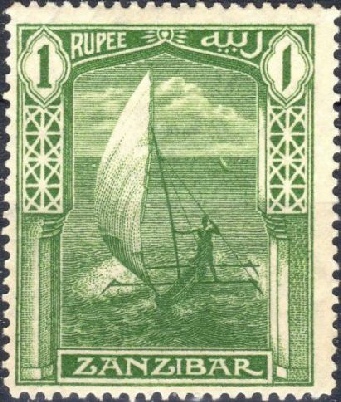
(7) THE OUTRIGGER CANOE in this Zanzibar stamp, in use 1913-
This appears to support the belief that the lateen was derived by the Egyptians from their square-
A commemorative stamp of New Zealand (8) pictures the traditional story of the arrival of the canoe Te Arawa and her companion vessels after a voyage of about 2,000 miles from the Cook and Society Islands.
Details of this voyage have been handed down by tradition, and it can be taken that the drawing of the canoe and her rig is reasonably accurate. The Te Arawa was the most famous of the canoes that tradition says brought the Maoris to their islands, The date of this canoe was about A.D. 1300, but there are records of others that date nearly a thousand years earlier.
It is probable, therefore, that the fore-
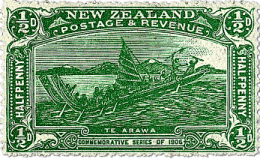
(8) ACCORDING TO TRADITION, a Maori canoe named the Te Arawa first brought the Maori settlers to New Zealand from the Cook and Society Islands 2,000 miles away. This stamp was issued in 1906 to commemorate the New Zealand Exhibition held at Christchurch.
Tradition and legend again tell that there was regular communication from time immemorial between certain groups of the Pacific Islands. The line of communication lay straight across the one unshifting direction of the prevailing trade winds, and only the fore-
It may be, therefore, that the lateen was first known in the East and was brought by the Arabs to Egypt and Europe. After the Arab conquest the lateen came into general use in the Mediterranean. It was later partly adopted all over Europe, and persisted for many centuries in the ocean-
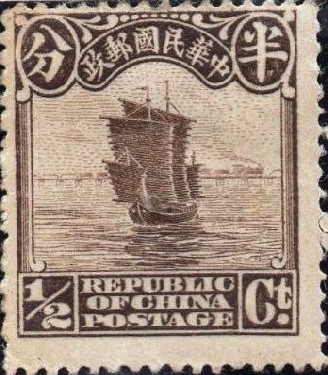
(9) THE SQUARE-
Although the Chinese scorned the fore-
The junk’s four sails are of a size and placing that came to be used only hundreds, if not thousands, of years later in Europe. The small sail on a mast stepped right up in the bows and leaning well forward is the equivalent of the square-
This sail, called artemon by the Romans, who borrowed the name from the Greeks, was the most important and valuable discovery made in sailing since man first used the wind to propel a vessel. With a single mast and square-
It is extraordinary that this invaluable discovery of the artemon should have been discarded after a short period. Its use was forgotten for centuries, only to be rediscovered as something entirely new and installed as a bowsprit-
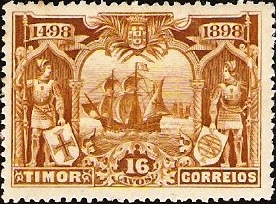
(10) VASCO DA GAMA’S FLAGSHIP, the Sao Gabriel, was the ship in which he rounded the Cape of Good Hope and discovered the route to India in 1498. This Timor stamp is one of a series issued in Portugal and her colonies in 1898.
The difference between the bow-
The lateen sail came into common use in the Mediterranean about the sixth or seventh century. Up to then the square-
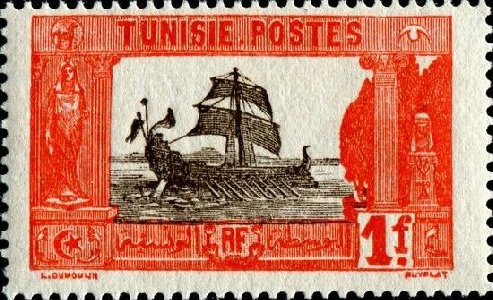
(11) CARTHAGINIAN GALLEY, with two square-
Although the square-
The Norse galleys were typical of north European ship design, and it is surprising that even after the Roman conquest and the colonization of Gaul and Britain, the northern type persisted against all the influence of the south. We have learned full details of the construction of these northern boats from remains recently excavated.
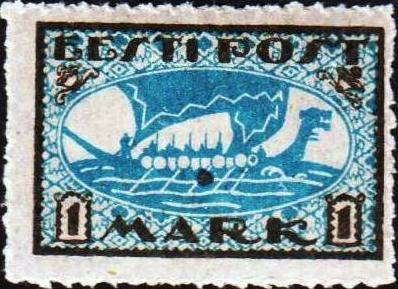
(12) A GALLEY with bows and stern differently shaped is shown in the Estonian stamp issued in May 1919.
The “Nydam boat” was dug up out of a marsh in Schleswig in 1863, and coins and other evidence found in her date her about A.D. 217. Her remains are in the Kiel Museum. Another boat found at the same time was unfortunately destroyed. This boat was fitted with a form of beak or ram at either end. In the London Museum is preserved a specimen of shipbuilding of about the same date; and at Oslo (Norway) are two well-
The Estonian stamp (12) shows a galley with bow and stern differently shaped, although according to archaeological evidence we know that this is incorrect.

(13) THE SHAPE of a North European galley is more correctly shown in the United States stamp, although the jib-
In the “Norse-
The ship on the Iceland stamp (14) is more correct, although the artist has drawn different shapes of bow and stern. The vertical stem is also wrong, because all precedents favour the curved stem as seen in the American stamp (13).
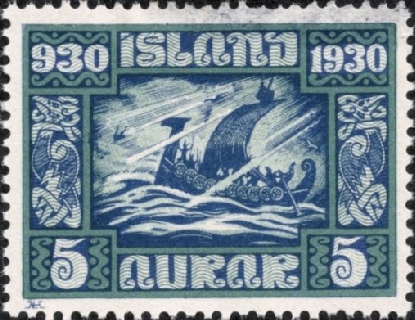
(14) THE VERTICAL STEM of the galley on the Iceland stamp, issued in 1930, should be curved. The United States stamp (13) shows the more correct form.
From about the sixth century the lateen sail rapidly displaced the square-
The word mizen is derived from the Arabic word mizan or misan, meaning a balance or compensation, and because such a balancing sail could either be placed right fore or aft, the sail was first brought north as a mizan placed in either position. The meaning of the English word mizen is corrupted when it denotes an after mast and sail, and the French word misaine, also corrupt, means a foremast.
The extreme to which the lateen was developed as the primary sail is illustrated -
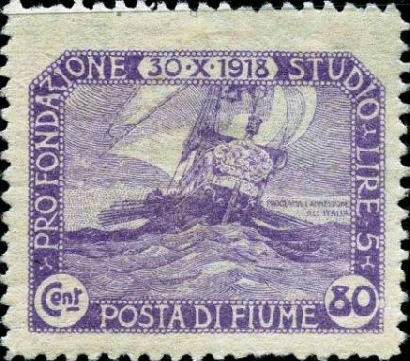
(15) A VENETIAN GALLEY with two huge lateen sails and a single bank of oars. This represents the extreme development of the lateen sail. The Fiume stamp was issued in May 1919, to mark the 200th day of peace after the war of 1914-
It is almost certain that such a galley would be a warship, because we know that as far back as the second century the Roman merchant and cargo ships depended on sails rather than on oars. The warship, however, was propelled by oars because oars either helped the speed under sail or allowed the ship to be manoeuvred and steered in any direction with the sails furled.
A sea battle in the days of oared galleys was normally fought under oar power. A primary aim of opposing ships was to drive the stem into the enemy’s oars and splinter them. The rowers would be killed by the blows of the violently jerked ends of the heavy oars. Sometimes the galleys would crash their under-
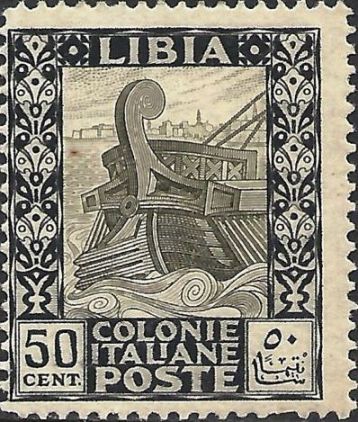
(16) THE WAR-
A Libyan stamp (16) shows a ram on a galley leaving Tripoli. This North African port was once the stronghold of corsairs who preyed with such success on the shipping of all nations that many countries paid an indemnity for immunity against attack. This payment continued so long that in 1801-
When sailing warships adopted a jib-
The shape of the bows of a battleship and the forward curve of the stem from the water-
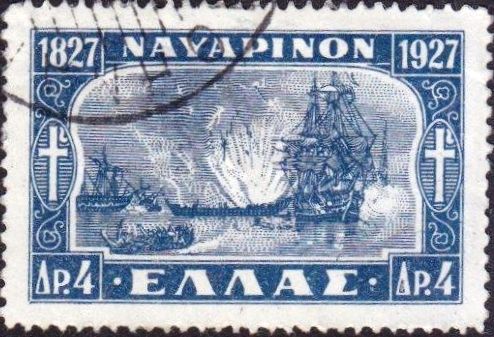
(17) THE BATTLE OF NAVARINO was fought off the west coast of Greece in 1827, during the War of Greek Independence, by the British, French and Russian fleets against the Turks and Egyptians. One hundred years later this Greek stamp was issued. It illustrates the type of warship that was in use in 1827.
Some years earlier, Robert Fulton, the American inventor, had designed a steam-
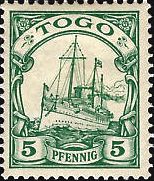
(18) The stamp illustrated here was issued by the German colony of Togoland. Examples of these stamps were overprinted during the Anglo-
Another stage in the development of the sailing ship was marked by the use of more than one mast. Although lateen-
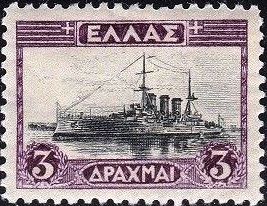
(19) A BATTLESHIP RAM is formed by the bows of the Greek cruiser Averoff, 9,450 tons displacement, depicted in the 3-
The rig of the ships of the fleet of Columbus in the U.S.A. “1492-
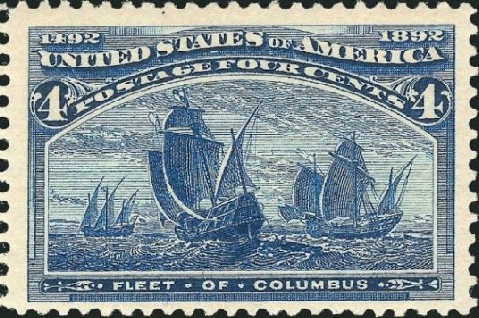
(20) THE CARAVELS OF COLUMBUS are shown in this United States stamp, one of a series issued in 1893 during the Columbian Exposition at Chicago to commemorate the discovery of America.
Design and rig were scarcely altered during the next hundred years. The “Pilgrim Tercentenary -
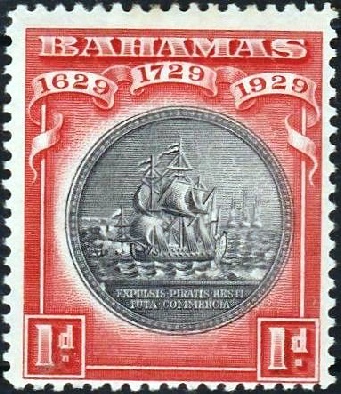
(21) A TYPE OF RIGGING that has been discarded is shown in this Bahamas stamp issued in 1929. A set of sails was added to a jack-
It was not until a long time afterwards that the next improvement in rig was made by the use of the ropes staying the foremast to carry a jib-
Before the jib-
With the bowsprit cleared of crossing yards, it was now possible to add to the number of stays forward from the fore mast to points along the bowsprit. Later, stays were added to the jib-
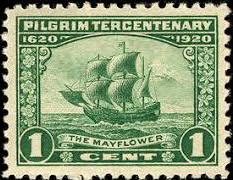
(22) THE FAMOUS MAYFLOWER that carried the Pilgrim Fathers to America in 1620 is illustrated in this United States stamp, issued to commemorate her tercentenary. The Mayflower’s rigging was almost the same as that of the Sao Gabriel, illustrated at (10) above.
This change to jib-
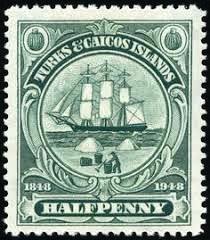
(23) THE EIGHTEENTH CENTURY SHIP on the Turks and Caicos Islands stamp has no square-
The lateen mizen was in use until the beginning of the seventeenth century, and about the middle of that century it had been accepted that the part of the sail which came forward of the mast had little power. This forward half was cut away, leaving the long lateen yard slanting up aft from the deck to the mast without any sail on it. The forward edge of the sail was left aft of the mast and laced to it, but the sail-
On the stamp of the Turks and Caicos Islands (23) is illustrated a vessel whose foremast and mainmast carry the square sails from yard to deck level, and the mizenmast has no square-
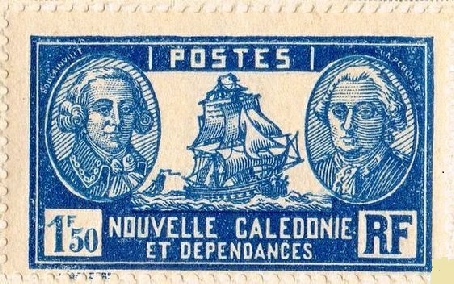
(24) SHIPS OF THE EIGHTEENTH CENTURY were the first to carry jib-
The sweep of the sailless lower half of the lateen yard across the lower part of the mast prevented any sail from being set across the lower mizenmast. After the useless part of the lateen yard had been cut off, although there was no longer anything to interfere with a square-
How in later days a sail was set on this barren yard across the mast forward of the spanker is illustrated in a Romanian stamp (27) issued in 1931. This shows a brig that is used as a training or cadet ship. On the mainmast the lower square-
with the spanker protruding astern of it. The same plan was followed on the mizen of a three-
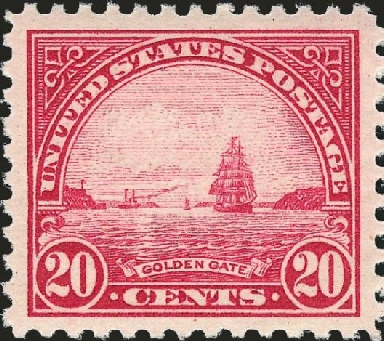
(25) A CLIPPER SHIP entering the Golden Gate, San Francisco, is shown on this 20-
Ship development in the clipper times consisted mainly of the improvement in the lines of the hull and the piling on of sail to give more speed.
Studding-
Purpose of Studding-
The vessel on the Liberian stamp (28) shows clearly how the studding-
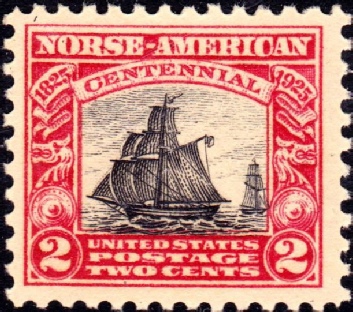
(26) The sloop Restaurationen that brought the first Norwegian emigrants to New York in 1825 is shown in the Norse-
Another picture of these sails is in a United States stamp (26) showing the sloop Restaurationen. In her the first batch of Norwegian emigrants reached New York in 1825. It is in commemoration of this event that she is shown in the “Norse-
Economic pressure and the competition of steam forced the cutting down of the clippers’ vast sail area. Ships could not afford to carry the large crews required to handle such masses of sails, and one after another they were reduced in size or abolished.
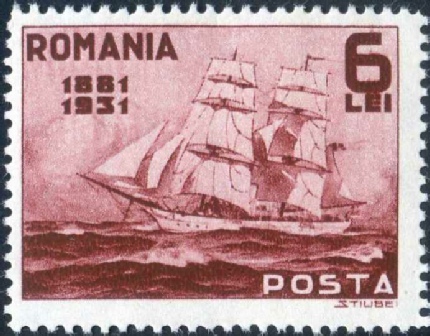
(27) A BEAUTIFUL BRIG used as a cadet training ship is shown in this Romanian stamp issued in 1931. A spanker sail can be seen astern of the lower square-
The 2-
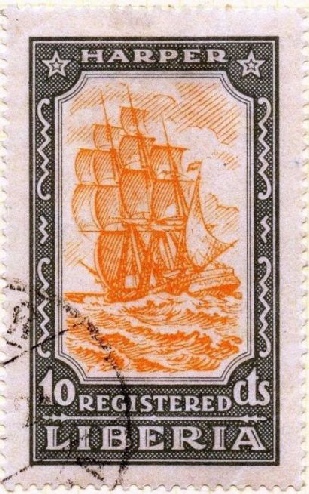
(28) STUDDING-
One United States stamp (25) shows a magnificent picture of a clipper ship entering the Golden Gate -
It might almost seem that this stamp was designed to symbolize the doom that was already overshadowing the glory of sail and the reign of the proud clipper ship queens of the ocean. For beyond the ship sailing in and beginning to shorten down for her anchorage, we see a black speck and a trailing smudge of smoke across the far horizon -
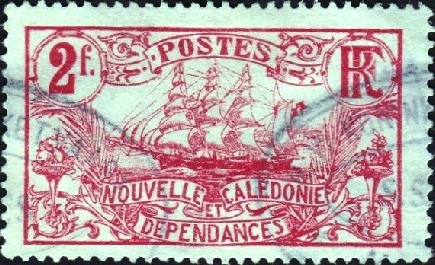
(29) THE REDUCED SAIL PLAN of later sailing vessels is shown in this stamp of New Caledonia issued in 1905-
You can read more on “Handling the Overseas Mail”, “Ships in Miniature” and “Speed Under Sail” on this website.